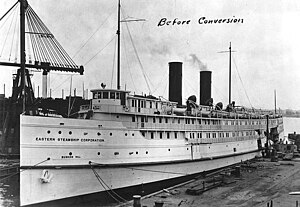 Bunker Hill with the passenger superstructure that was added in 1911
| |
| History | |
|---|---|
| Name |
|
| Namesake |
|
| Owner |
|
| Operator | 1917: United States Navy |
| Port of registry |
|
| Route |
|
| Builder | Wm Cramp & Sons, Philadelphia |
| Yard number | 343 |
| Launched | 26 March 1907 |
| Sponsored by | Rose Fitzgerald |
| Completed | 1907 |
| Acquired | for US Navy, 12 November 1917 |
| Commissioned | 7 December 1917 |
| Decommissioned | 10 March 1931 |
| Maiden voyage | 11 July 1907 |
| Refit | 1911; 1917; 1919 |
| Stricken | 5 February 1943 |
| Identification |
|
| Fate | scrapped, 1947 |
| General characteristics | |
| Type |
|
| Tonnage | |
| Displacement | 1918: 3,800 long tons (3,900 t) |
| Length | |
| Beam | 52.2 ft (15.9 m) |
| Draft | 16 ft 0 in (4.88 m) |
| Depth |
|
| Decks | 2 |
| Installed power | 674 NHP; 7,500 ihp |
| Propulsion |
|
| Speed | 20 knots (37 km/h) |
| Capacity |
|
| Complement | in US Navy, 313 |
| Crew |
|
| Armament | |
USS Aroostook (ID-1256 / CM-3 / AK-44) was a steamship that was built as the coastal cargo liner Bunker Hill. She was launched in 1907 by Rose Fitzgerald, who in 1914 became Rose Kennedy. In 1911 Bunker Hill was refitted as a passenger ship. She ran between Boston and New York until 1917, when the United States Navy commissioned her as USS Aroostook, and converted her into a minelayer. In 1918 she took part in laying the North Sea Mine Barrage.
In 1919 Aroostook was converted into a flying boat tender, and supported the US Navy's successful attempt to fly a flying boat from North America to Europe. In 1925 she supported the Navy's unsuccessful attempt to fly a flying boat from California to Hawaii, and led the search for the aircraft after it had to touch down in mid-ocean. In 1931 she was decommissioned and placed in the reserve fleet.
In 1941 the Navy tried to convert Aroostook back into a cargo ship, but found it impractical due to her age. She was stricken from the Naval Register in 1943, and her name was reverted to Bunker Hill. In 1946 the former boot-legger Anthony Cornero bought her, renamed her Lux, and had her converted into a gambling ship. The United States Coast Guard seized her, and in 1947 she was scrapped.